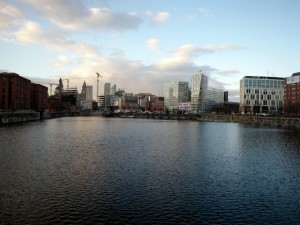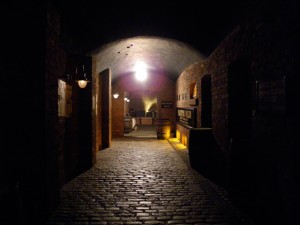Everybody goes to Liverpool to remember the Beatles. It’s appropriate, of course, since they are still the towns most famous export. However, they are probably not the town’s most important legacy — that honor, in my opinion, belongs to its role as the main jumping off point for thousands upon thousands of European immigrants to the New World in the 19th and early 20th centuries.
During the mid-1800s, Liverpool emerged as the main port for English migrants to America. The U.S. had dominated the trade before the Civil War, using sailing ships, but the ravaged U.S. economy afterwards, and Britain’s innovations in steam transport, eventually led to the British dominance of the trade. The White Star Line (of Titanic infamy) and the Cunard Line emerged as the world leaders in passenger transport, and both were based in Liverpool. Emigrants from all over Europe converged on Liverpool to board America- or Australia-bound ships at the height of the Industrial Revolution.
My own Norwegian great-grandparents immigrated to the U.S. in 1903. I have a copy of my great-grandfather’s ticket from Kristiansand, Norway, through Liverpool to New York. The lower floor of Liverpool’s Maritime Museum is dedicated to the city’s role in European emigration (an entire museum dedicated to the subject is currently under construction), and I couldn’t help but think about my family as I wandered through the displays on the city that emigrants might have encountered 100 or 150 years ago.
Before the turn of the 20th century, multiple families were crammed into tiny rooms in tenement houses, lacking basic sanitation, and deaths were common before families even boarded the ships. Eventually, regulation and the dominance of the main companies led to better conditions. By the time the Bjornaraas came through, things had improved significantly. Tenement houses had been cleaned up, more and better temporary lodgings had been constructed, and the major companies began including Liverpool lodging under the auspices of the tickets purchased by passengers. My great-grandfather’s ticket reads, “During the whole journey hence to New York, passengers will be supplied with good and sufficient food, as well as with suitable lodging.”
Some of the Europeans headed to the New World had never left their hometowns before, let alone their home countries. The Bjornaraas had moved to Kristiansand from Valle to teach before they left for America, but I’m not sure if they had ever left Norway before. I wondered what my family might have been thinking as they walked those same streets 100 years before, anxiously waiting for their new life to begin.
My great-grandmother was apparently pregnant at the time, so her experience must have been doubly stressful: Going to America to build a new life was probably both exciting and terrifying, and knowing that her first child would be born an American probably heightened all of those feelings of hope and regret. My great-grandfather did take a trip back to Norway in the 1930s, but as far as I know, my great-grandmother never went back to her homeland.
I am soon on my way to Norway. I’ll hopefully be meeting the later generations of the side of the family that stayed in Norway. In a way, it’s appropriate that I visited Liverpool first, this transition point that was so rife with human emotion. For me to pass through this stopover — their last chance to turn around and decide it was all too much — was sort of like going through their immigration in reverse (though at the moment I have no plans to immigrate to Norway). I looked out over the Mersey estuary toward the Atlantic Ocean, thinking they had probably once stood here and done the same thing. They kept going, boarding a ship and sailing into New York harbor, while I turned around and got on a train heading north.



{ 3 comments… read them below or add one }
If such passage is possible, I bet this sensitive account rouses your ancestors’ spirits to take that train with you….If it’s not possible, they’ll probably attempt it anyway–it’s always too much, to go on, to stay, to turn back–the heart claims a stake and risks its beat regardless of its decisions. You have me hooked. Love, Donna
Hi Britta,
I just spoke with my librarian today who mentioned her relatives from Norway were in town visiting soon to return home. They are from Kristiansand! I gave her your # ( I hope that is ok) and let them know you might be town in the near future. Their names areTorjan and Bitte Wikstol. They have 2 daughters around your age in the area. I am so excited that you are in Norway!!!! Can’t wait to hear what you discover!!! Take care and enjoy the lutefisk (cause if you don’t telll your children…who will?!)
Much love, Cindy
So jealous – I LOVE NORWAY – all the great history – and the topography looks like Alaska (the best place to live). If you make it to Stavanger – please email and I’ll send you a contact for relatives in my family to visit. Sandness is a small town near Stavanger with the best indoor water park – worth checking out. There are nine members in Norway from 5W – let me know if I should email. Your membership book is here with the most current listing.